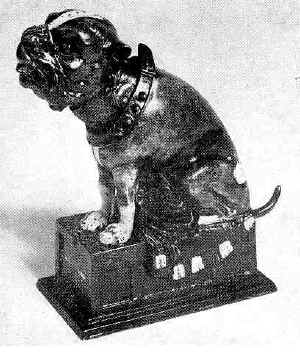Bull Dog Bank
by F.H. Griffith - HOBBIES Magazine - July, 1974
 There is no question that certain mechanical banks have more
appeal than others and that this appeal varies from collector to collector. Many and
varied are the reasons why a certain mechanical bank is a favorite to different
individuals. The subject matter of a bank is most certainly a governing factor and this
had a lot to do with its general popularity during the period in which it was made. Some
mechanicals were made over a period of years due to their general appeal to the public and
to satisfy the demand quantities of the respective banks were manufactured. In most cases
this popularity has carried down to the collector of today. That is to say some of the
more available mechanicals are very definitely favorites of many of today’s
collectors.
There is no question that certain mechanical banks have more
appeal than others and that this appeal varies from collector to collector. Many and
varied are the reasons why a certain mechanical bank is a favorite to different
individuals. The subject matter of a bank is most certainly a governing factor and this
had a lot to do with its general popularity during the period in which it was made. Some
mechanicals were made over a period of years due to their general appeal to the public and
to satisfy the demand quantities of the respective banks were manufactured. In most cases
this popularity has carried down to the collector of today. That is to say some of the
more available mechanicals are very definitely favorites of many of today’s
collectors.
It would be difficult, for example, to imagine anyone saying they disliked the Tammany Bank, certainly one of the most common of the mechanicals. Well this was the favorite of all the mechanical banks to the late John D. Meyer and he kept it under a special glass dome in his collection. He had his reasons for this, of course, as we all do with respect to certain favorite banks, and they need not be rare or highly valuable mechanicals.
Certainly our choice as No. 237 in the numerical classification, the Bull Dog Bank, well represents one of the favorites of many mechanical bank collectors, including the writer. It has appealing subject matter, exceptionally clever action, and while somewhat fierce in its appearance, it is a rather good looking proportionate bank. It was a popular item in its day and that popularity continues with today’s collectors.
The Bull Dog Bank was patented April 27, 1880 by J. H. Bowen of Philadelphia, Pa. It was made by the J. &. E. Stevens Company, of Cromwell, Conn. Stevens in manufacturing the bank fairly well followed the outline and drawings of the patent. Bowen was one of the more talented designers of mechanical banks and to the best of our knowledge all of his patented mechanicals were manufactured by Stevens. He certainly had a fine touch with clever mechanisms and all of the mechanicals he designed enjoyed wide popularity in their day.
The Bull Dog Bank shown is in exceptionally fine all original condition with colors as follows: The figure of the dog is of the brindle type, mottled brown with white markings. He has brown glass eyes and a red tongue. His collar is dark brown with gold spikes and buckle. The dog sits on a blue drape effect with white highlighted fringe. This in turn, the dog and drape, are on a rectangular box-like affair painted dark brown. The name "Bull Dog Bank" is in red. This does not show in the picture as it is along the opposite side plate in large letters. The underside of the base plate is perforated with round holes and the patent date appears as follows: ‘PATD APR 27 1880’. A conventional type round Stevens trap is in the base plate.
To operate the bank a coin is first placed on the provided space on top of the dog’s nose. The dog’s tail is then pulled down. This causes the neck to recede into the body as his mouth snaps open (lower jaw drops down). The rear part of the coin rest section on the nose rises up and this causes the coin to slide forward from the nose dropping into the open mouth and on through the body of the dog into the base receptacle. Releasing the tail all parts return automatically to the positions as shown in the photo. It’s a nice action bank and leaves little to be desired in this area. The mechanical operation of catching the coin in the mouth from the nose is unique and there is no other old mechanical bank like it. In the modern category of the mechanicals there is a Scottie Dog that does the same trick.
A final word — the Bull Dog Bank possibly more often than brindle coloring has the dog painted black with white spots, and in this case the drape is red and the base section black.
